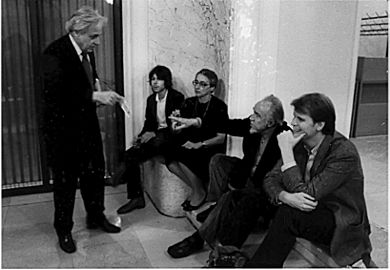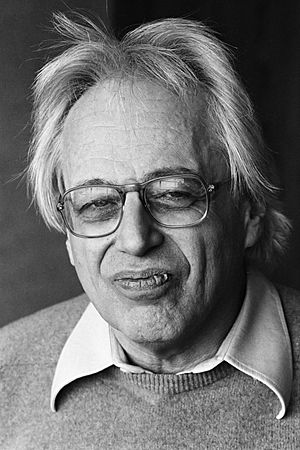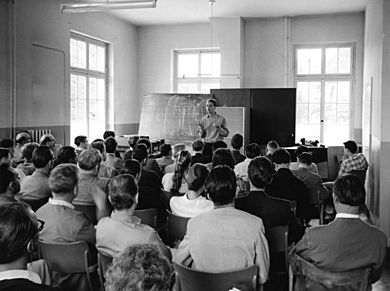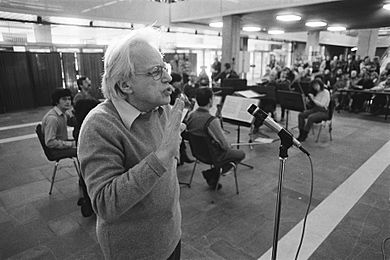György Ligeti facts for kids
György Sándor Ligeti (born May 28, 1923 – died June 12, 2006) was a famous composer from Hungary and Austria. He is known as one of the most important and creative composers of modern classical music in the second half of the 1900s.
He was born in Transylvania, Romania. He lived in Hungary before moving to Austria in 1956. He became an Austrian citizen in 1968. From 1973 to 1989, he was a professor of composition at the Hamburg University of Music and Theater. He passed away in Vienna in 2006.
In Hungary, the government limited his musical style. When he moved to the West in 1956, Ligeti could finally explore his passion for new and experimental music. He developed many new ways to compose. After trying out electronic music in Cologne, Germany, he became well-known for orchestral works like Atmosphères. For this piece, he used a technique he called micropolyphony. Later, after writing his opera Le Grand Macabre, Ligeti started focusing more on complex rhythms, known as polyrhythm.
Many people know his music from film soundtracks. Even though he didn't write music directly for movies, parts of his pieces were used and changed for films. For example, Stanley Kubrick's movie 2001: A Space Odyssey used several of Ligeti's works.
Contents
Life Story of György Ligeti
Early Years and Family Life
Ligeti was born in 1923 in a town called Diciosânmartin (now Târnăveni) in Transylvania, Romania. His parents were Dr. Sándor Ligeti and Dr. Ilona Somogyi. His family was Hungarian Jewish. He was also related to the famous violinist Leopold Auer.
Ligeti remembered that he first heard other languages when he listened to Romanian-speaking police officers. Before that, he didn't know other languages existed. When he was six, his family moved to Cluj. He did not visit his birthplace again until the 1990s. In 1940, Northern Transylvania became part of Hungary.
In 1941, Ligeti began his music studies at the conservatory in Kolozsvár (Cluj). During the summers, he studied privately with Pál Kadosa in Budapest. In 1944, his studies were stopped. He was sent to a forced labor brigade during World War II. His 16-year-old brother, Gábor, was sent to a concentration camp, and both his parents were sent to Auschwitz. Only his mother survived from his close family.
After World War II, Ligeti returned to his studies in Budapest. He graduated in 1949 from the Franz Liszt Academy of Music. He studied with famous teachers like Pál Kadosa, Ferenc Farkas, Zoltán Kodály, and Sándor Veress. He also researched Hungarian folk music in Transylvania. After a year, he returned to the Franz Liszt Academy as a teacher. He taught from 1950 to 1956. Because of the communist government, it was hard for artists in Hungary to connect with the rest of the world.
Moving to the West
In December 1956, after the Hungarian Revolution of 1956 was stopped by the Soviet Army, Ligeti escaped to Vienna with his ex-wife Vera Spitz. They remarried in 1957 and had a son. He did not return to Hungary for 14 years. When he fled, he left most of his old music behind, and some of it is now lost. He only took the pieces he thought were most important. He later said he didn't think his old music was interesting. He became an Austrian citizen in 1968.
A few weeks after arriving in Vienna, Ligeti went to Cologne, Germany. There, he met important avant-garde composers like Karlheinz Stockhausen and Gottfried Michael Koenig. They were working on new electronic music. Ligeti worked in the Cologne Electronic Music Studio and was inspired by the sounds. However, he created only a few electronic pieces himself. Instead, he focused on instrumental music that often sounded like electronic music.
After about three years, he stopped working with the Cologne group. He said there was too much fighting among the composers about who was most important.
From 1961 to 1971, he was a guest professor in Stockholm. In 1972, he became a composer-in-residence at Stanford University in the United States. In 1973, Ligeti became a professor of composition in Hamburg, Germany, and retired in 1989. While he lived in Hamburg, his wife Vera and son Lukas stayed in Vienna. Lukas also became a composer.
Ligeti was interested in many things besides music. He loved literature, painting, architecture, science, and mathematics. He was especially fascinated by fractal geometry and the writings of Douglas Hofstadter.
Later Years and Passing
Ligeti's health got worse after the year 2000. He passed away in Vienna on June 12, 2006, at the age of 83. He had been ill for several years and used a wheelchair for the last three years of his life. His family did not share details about the cause of his death.
Austrian leaders honored Ligeti. His funeral was held in Vienna. His ashes were buried in the Vienna Central Cemetery in a special "grave of honor." He is buried next to his brother. He was survived by his wife Vera and his son Lukas.
Ligeti's Musical Works
Early Compositions in Hungary
Many of Ligeti's first works were for chorus and included folk songs. One of his earliest well-known pieces is his Cello Sonata. It has two different movements and was written in 1948 and 1953. The Soviet-run Composer's Union banned it at first, so it wasn't performed publicly for 25 years.
Ligeti's early music often built on the style of Béla Bartók. His piano cycle Musica ricercata (1953) was written with a very strict approach. In this piece, Ligeti used a simple rule: the first piece uses only one note, A. The second piece uses three notes, the third uses four, and so on. The last piece uses all twelve notes of the chromatic scale.
Six movements from Musica ricercata were arranged for a wind quintet and called 'Six Bagatelles for Wind Quintet'. They were first performed in 1956, but the last movement was censored by the Soviets for being too "dangerous."
Because of Soviet censorship, some of his most daring works from this time, like Musica ricercata and his String Quartet No. 1 Métamorphoses nocturnes (1953–1954), were not performed publicly. The First String Quartet was not heard until 1958, after he had left Hungary.
From 1956 to Le Grand Macabre
When Ligeti arrived in Cologne, he started writing electronic music with Karlheinz Stockhausen and Gottfried Michael Koenig. He only finished two electronic pieces, Glissandi (1957) and Artikulation (1958), before going back to instrumental music.
Ligeti's music was later influenced by his electronic experiments. Many of his sounds resembled electronic textures. Ligeti created the term "micropolyphony" to describe the sound of his pieces like Apparitions (1958–59) and Atmosphères (1961). This technique involves many musical lines that are so close together they create a dense, rich sound. It can make music sound almost still but slowly changing, like in Atmosphères. Ligeti said he became famous after these two works.
With Volumina (1961–62) for solo organ, Ligeti continued using clusters of notes. In this piece, he didn't use traditional music notes. Instead, he used diagrams to show general pitch areas and how long notes should last.
Poème symphonique (1962) is a piece for 100 mechanical metronomes.
Aventures (1962) and Nouvelles Aventures (1962–65) are for three singers and seven instruments. The singers use made-up words that have no real meaning. Each singer plays five different emotional roles, switching quickly between them.
His Requiem (1963–65) is a long piece for singers and orchestra. It uses parts of the traditional Requiem text, like the "Kyrie" and "Dies irae".
Lux Aeterna (1966) is a piece for 16 voices without instruments. Its text is also from the Latin Requiem.
Ligeti's Cello Concerto (1966) has two movements. The first starts very quietly and slowly builds up. The second movement is a fast and complex piece for the cello.
Lontano (1967) for orchestra is another example of micropolyphony. It creates a complex, woven sound that seems harmonious. It is now a standard piece in classical music concerts.
His String Quartet No. 2 (1968) has five movements, each with a different type of motion. The movements explore various musical ideas, from broken structures to very slow, distant sounds, and mechanical rhythms.
In the Chamber Concerto (1969–70), many musical layers and movements happen at the same time. Ligeti was fascinated by machines that don't work perfectly, and this piece sounds like a "precision mechanism."
Most of these pieces focus on the timbre (the quality of the sound) rather than just pitch and rhythm. From the 1970s, Ligeti started to focus more on rhythm. Pieces like Continuum (1968) and Clocks and Clouds (1972–73) show this change. He was also interested in the polyphonic pipe music of the Banda-Linda tribe from Africa.
In 1977, Ligeti finished his only opera, Le Grand Macabre. It is a play about Death arriving in a fictional city and announcing the end of the world. Musically, it uses different techniques than his earlier works, including sounds that are more harmonious.
After Le Grand Macabre

After Le Grand Macabre, Ligeti worked to find a new style. He didn't finish another major work until the Trio for Violin, Horn and Piano in 1982. His music in the 1980s and 1990s continued to use complex rhythms. He also explored different ways of tuning instruments. Most of his works from this time have multiple movements, unlike his earlier long single-movement pieces.
From 1985 to 2001, Ligeti wrote three books of Études for piano. These 18 pieces were inspired by many sources, including gamelan music, African polyrhythms, and the music of Béla Bartók. Ligeti's music from his later years is known for its complex rhythms. He said this came from the Romantic piano music of Frédéric Chopin and Robert Schumann, and from the traditional music of sub-Saharan Africa.
The main difference in his later music is how he used pulse (the basic beat). In his earlier works, the pulse was divided into smaller parts. In his later music, the pulse was like a basic unit that couldn't be divided further. Different rhythms were created by multiplying this basic pulse. This idea comes from African music and also from the additive rhythms of Balkan folk music, which Ligeti knew from his youth.
In 1988, Ligeti finished his Piano Concerto. He said it showed his independence from old and new music trends. He started sketching the Concerto in 1980, but it wasn't until 1985 that he found the right direction for it. The Concerto explores many ideas from his Études but with an orchestra.
In 1993, Ligeti completed his Violin Concerto after four years of work. Like the Piano Concerto, it uses many techniques he had developed. It includes a passacaglia, microtonality (very small pitch differences), fast-changing sounds, and references to Hungarian folk music, Bulgarian dances, and older music from the Middle Ages and Renaissance music.
Other important works from this time are the Viola Sonata (1994) and the Nonsense Madrigals (1988–93). The Madrigals are six pieces for voices without instruments, using funny English texts by writers like Lewis Carroll.
Ligeti's last works were the Hamburg Concerto for horn and chamber orchestra (1998–99) and the song cycle Síppal, dobbal, nádihegedűvel ("With Pipes, Drums, Fiddles", 2000). He also planned to write a second opera, but it was never finished.
Ligeti's Impact and Fame
Ligeti is seen as one of the most creative and important composers of his time, alongside Pierre Boulez, Luciano Berio, Karlheinz Stockhausen, and John Cage. From about 1960, his music became more widely known and respected. His most famous works were written between 1958 and 1977, including Atmosphères, Requiem, Lux Aeterna, and his opera Le Grand Macabre. In recent years, his three books of piano études have also become very popular.
Music in Stanley Kubrick's Films
Ligeti's music is most widely known because it was used in three films by Stanley Kubrick. This brought his music to a worldwide audience. The soundtrack for 2001: A Space Odyssey includes parts from four of his pieces: Atmosphères, Lux Aeterna, Requiem, and Aventures.
- Atmosphères is heard during the "Star Gate" scene.
- Lux Aeterna is heard in the moon-bus scene.
- The Kyrie part of his Requiem is heard during the first three encounters with the mysterious monoliths.
- An electronically changed version of Aventures is heard in the final scenes.
Kubrick used Ligeti's music without his full permission at first. Ligeti later sued because his music was changed. They settled the issue, and Kubrick then got permission and paid Ligeti for using his music in later films.
Lux Aeterna was used again in the 1984 movie 2010, which was a sequel to 2001. Another Kubrick film, The Shining, used small parts of Ligeti's Lontano. A musical idea from the second movement of Ligeti's Musica ricercata is used at key moments in Kubrick's film Eyes Wide Shut.
Music in Other Films and Media
Ligeti's work has also been used in many other films. Lontano was used in the 2010 film Shutter Island. The first movement of the Cello Concerto was used in the 1995 crime film Heat. The Requiem was used in the 2014 film Godzilla. The Cello Concerto and the Piano Concerto were used in the 2017 film The Killing of a Sacred Deer.
His music has also appeared on television and radio. Lontano, Atmosphères, and the first movement of the Cello Concerto were used in the documentary Over Your Cities Grass Will Grow. Parts of Lontano, Melodien, and Volumina were used as background music in The Hitchhiker's Guide to the Galaxy radio series.
Awards and Honors
- Beethoven Prize of Bonn for Requiem (1967)
- UNESCO International Rostrum of Composers (1969)
- Berlin Art Prize (1972)
- Bach Prize of the Free and Hanseatic City of Hamburg (1975)
- Pour le Mérite for Sciences and Arts (1975)
- University of Louisville Grawemeyer Award for Music Composition (Etudes for Piano) (1986)
- Austrian Decoration for Science and Art (1987)
- Honorary Ring of the Vienna (1987)
- Commandeur dans l'Ordre des Arts et des Lettres (1988)
- Prix de composition musicale de la Fondation Prince Pierre de Monaco (1988)
- Léonie Sonning Music Prize (Denmark, 1990)
- Grand Austrian State Prize for Music (1990)
- Praemium Imperiale (1991)
- Balzan Prize (1991)
- Honorary Member of the Royal Academy of Music, London (1992)
- Ernst von Siemens Music Prize, Germany (1993)
- Rolf Schock Prize for Musical Arts (1995)
- Music Award of the UNESCO (1996)
- Wolf Prize in Arts, Israel (1996)
- Wihuri Sibelius Prize, Finland (2000)
- Kyoto Prize (2001)
- Medal of Arts and Sciences of the City of Hamburg (2003)
- Theodor W. Adorno Award (2003)
- Kossuth Prize, Hungary (2003)
- Polar Music Prize (2004)
- Frankfurt Music Prize (2005)
Honorary Doctorates
- Honorary doctor from the Universität Hamburg (1988)
Notable Students
Images for kids
See also
 In Spanish: György Ligeti para niños
In Spanish: György Ligeti para niños






